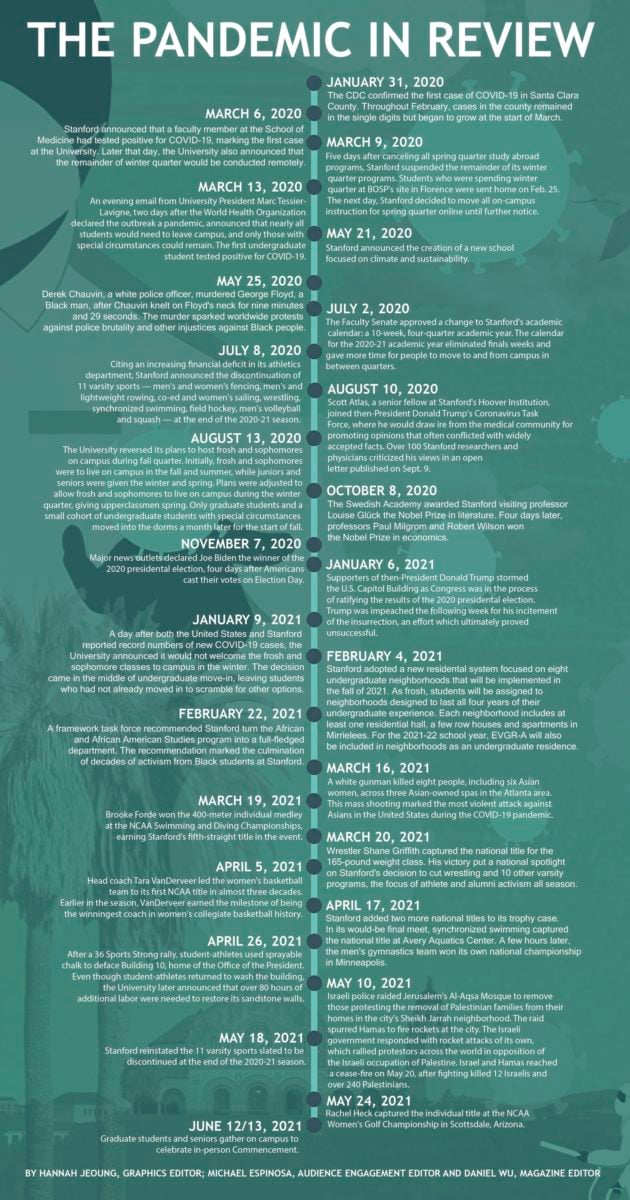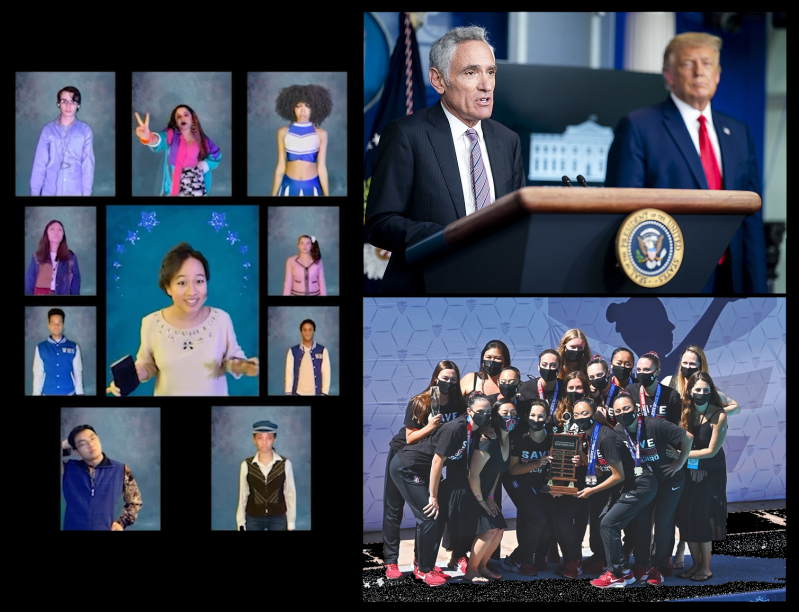What a year it’s been. On Sunday, graduates and their families will fill Stanford Stadium — another milestone on the University’s road out of the pandemic. The day’s commencement ceremony caps off the year with the largest upheaval at Stanford in decades. Students, from their homes scattered across the world, quarantined, took classes, conducted research and advocated for causes like the departmentalization of the African and African-American Studies (AAAS) program.

Academics
Kam Moler, vice provost and dean of research, and Stephan Graham, dean of the School of Earth, Energy & Environmental Sciences, have spent the past year designing the new school focused on climate and sustainability, while activists demand that the new school sever ties with fossil fuel companies.
Louise Glück, a visiting professor in the humanities, was awarded the Nobel Prize in Literature in October for what the Swedish Academy called “her unmistakable poetic voice.” She was joined by Paul Milgrom M.S. ’78, Ph.D. ’79 and Robert Wilson, whose work on auction theory earned them the Nobel Prize in Economic Sciences.
Scott Atlas was appointed to the White House Coronavirus Task Force by former president Donald Trump in July. The senior fellow at the Hoover Institution advocated for a herd immunity strategy that was eschewed in a September open letter by over 100 faculty, who specialize in epidemiology, infections diseases and health policy. In November, the Faculty Senate condemned Atlas for encouraging his followers to “rise up” against COVID-19 restrictions in Michigan and debated reevaluating the relationship between the Hoover Institution and Stanford altogether.
Activism
Black student organizers won a victory decades in the making when a framework task force recommended in February that the program in AAAS become a department, with the ability to hire its own faculty. The task force is currently in the process of developing more details about Stanford’s newest department.
In August, the Basic Needs Coalition launched a fundraising effort to make sure that all Stanford students had access to necessities. The group partnered with the American Mutual Aid Foundation and raised over $91,000 to fulfill student requests for housing, food, utilities and healthcare.
Stanford’s subcontracted workers continued to advocate for themselves, while working on the frontline of the pandemic as the University reopens. As they continue to keep our campus clean, they allege enduring harassment and discrimination from the management of custodial company UG2. In April, these workers sent a petition to President Marc Tessier-Lavigne demanding the removal of the upper management of UG2’s office at Stanford.
Abolish Stanford spent the year organizing to remove the presence of police from campus. The group was part of a coalition of eight which demanded equity and justice from the administration in a September “Reverse Town Hall.” Abolish Stanford, which also held a rally in Main Quad last month, shouldn’t be confused with Abolish Stanford Greek, the group aiming to eliminate fraternities and sororities from campus.
Arts
The pandemic forced a normally vibrant arts scene, like the rest of life on campus, online in March. However, as performance groups told us in March, “The Show Must Go On.” Chloe Chow ’23 produced Gaieties, one of Stanford’s most famous traditions, in an online format for the first time. Chow went on to co-direct “Question 27, Question 28,” a virtual piece of documentary theater, in the spring for the Asian-American Theater Project. In May, Ram’s Head Theatrical Society bent the rules of gender and digital theater with their production of “Heathers.” A cappella groups turned their in-person shows into YouTube premieres while the Stanford Shakespeare company took to the radio for their rendition of “The Tempest.”
Campus
Life on campus looked a lot different this year. Stanford made its first important change in July by adopting a new academic calendar, one that features four ten-week quarters, with longer breaks in between each to give students more time to move into and out of their residences. Fewer students than expected moved into those residences after the University abandoned plans to allow half of the undergraduate population to live on campus during fall and winter quarters. Those that did move in were faced with restrictions on dining and gathering.
Student life on campus will look different next year too. Stanford announced it would launch residential neighborhoods in the fall of 2021, following the recommendation of a ResX task force. Next year, new students will be assigned to a neighborhood, each with dorms, row houses and apartment-style housing, designed to last the entirety of their undergraduate careers.
Sports
The Cardinal took home three team national championships and eight individual national titles during the pandemic. Women’s basketball, under the leadership of Tara VanDerveer, won a national title that prompted a parade on campus. Two weeks later, both the synchronized swimming and men’s gymnastics teams won national titles of their own. Synchronized swimming senior Jacklyn Luu won the solo title and was part of the winning duet and team routines, making her the most decorated athlete of the year.
Of course Stanford’s July 8 decision to cut 11 varsity sports loomed over the rest of the entire season. The campaign to reinstate the sports received national attention after Shane Griffith took home a national title at the NCAA Wrestling Championships. The redshirt sophomore competed in an all-black singlet, rather than the traditional cardinal-red uniform, in protest of the University’s choice to cut his team.
Part of the campaign from 36 Sports Strong, the alumni advocacy group aiming to keep the number of Stanford varsity sports at 36, included a rally in Main Quad. After the April 26 rally, student-athletes defaced Building 10, home to the Office of the President, with sprayable chalk. Athletes returned to wash off the chalk, though the University said that 80 additional hours of labor from service workers would be needed to complete the restoration of the building. Stanford reinstated the 11 varsity sports on May 18.
